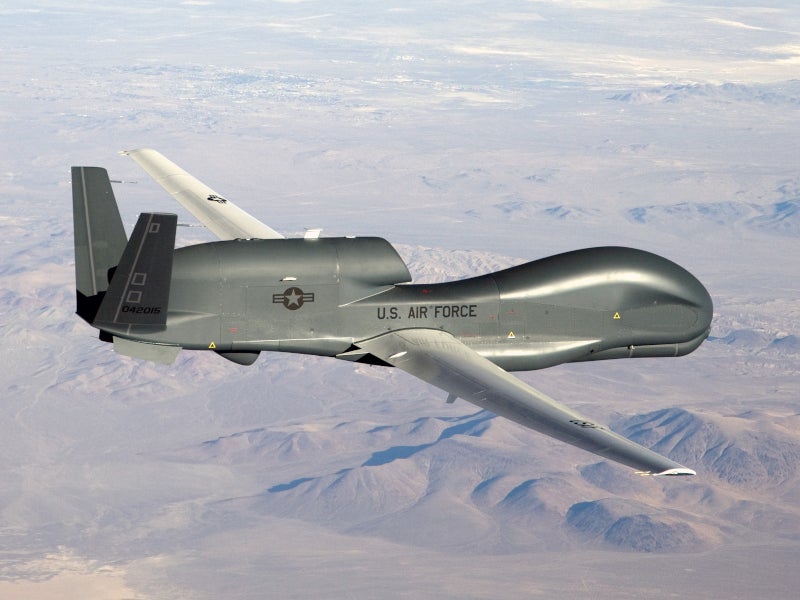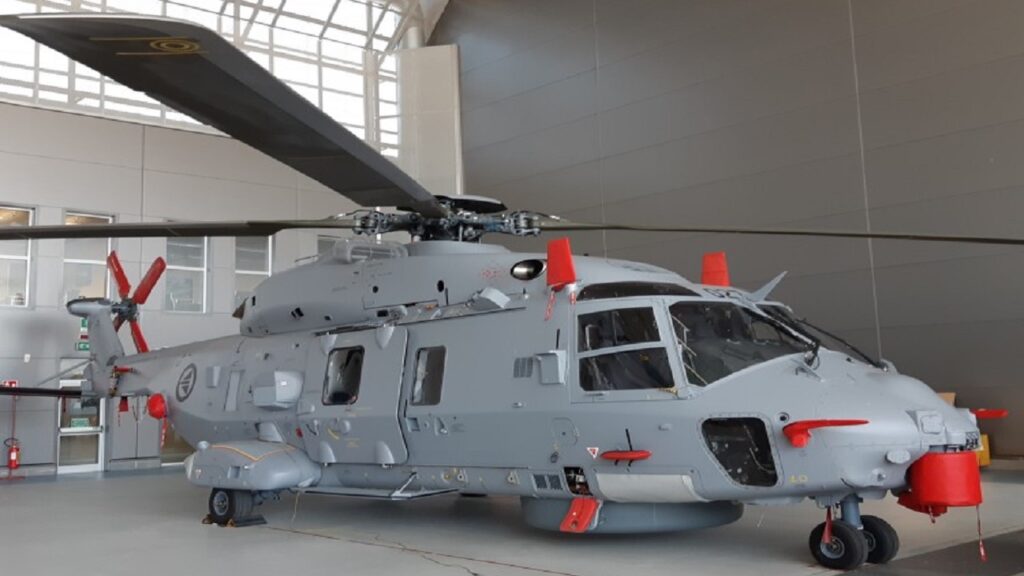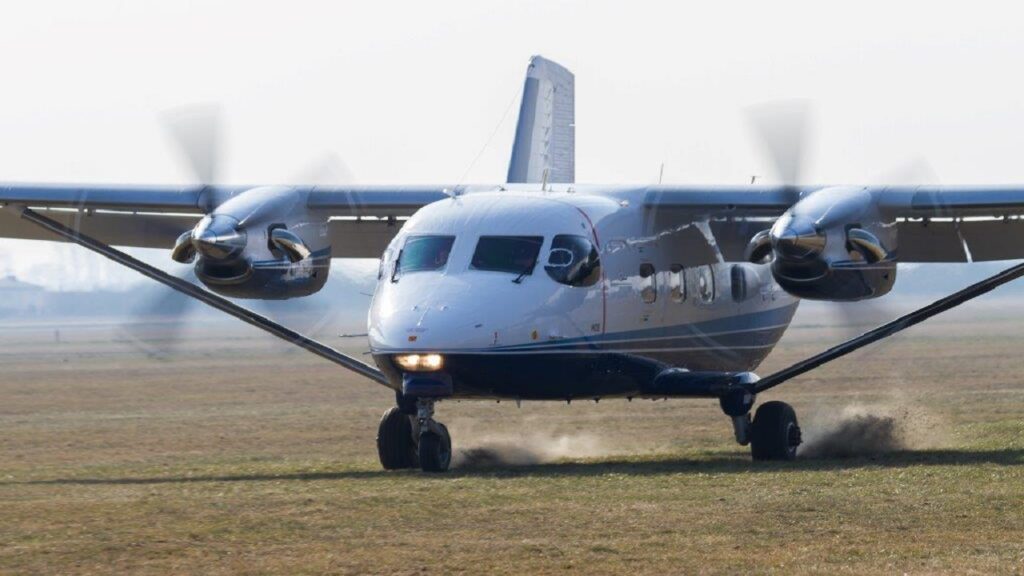
RQ-4A Global Hawk is a high-altitude, long-endurance unmanned aerial reconnaissance system which provides military field commanders with high resolution, near real-time imagery of large geographic areas.
The programme is funded by the Defense Airborne Reconnaissance Office (DARO) and managed by the Defense Advanced Research Projects Agency (DARPA) and the US Air Force.
Northrop Grumman Corporation, Ryan Aeronautical Centre is the prime contractor and the principal suppliers include Raytheon Systems (sensors), Rolls-Royce North America (turbofan engine), Boeing North American (carbon fibre wing) and L3 Communications (communications system).
The Global Hawk air vehicles are built at the Northrop Grumman (formerly Teledyne Ryan) aeronautical facility in San Diego.
Global Hawk UAV development
In March 2001, the US Department of Defense awarded Northrop Grumman a contract for the Engineering and Manufacturing Development (EMD) phase of the programme which concluded in February 2003 with the final delivery of the seventh pre-production (block 0) vehicle.
In June 2001 a contract was placed to begin low-rate initial production (LRIP) for two production air vehicles and the mission control element of the system’s ground station, to be completed by December 2003.
The first production vehicle (block 10) rolled out in August 2003. A further LRIP contract for four vehicles was placed in February 2003 and a third in October 2004 for two vehicles. Block 10 deliveries were completed in June 2006.
The US Navy had two RQ-4A air vehicles delivered in 2005. In April 2008, the USN selected the RQ-4N marinised variant of the Global Hawk RQ-4B Block 20 for the broad-area maritime surveillance (BAMS) unmanned aircraft system (UAS) requirement.
The system design and development (SDD) contract awarded to Northrop Grumman saw the delivery of two UAVs with mission payloads and communication suites, one forward operating base mission control system, one systems integration laboratory and one main operating base mission control system.
The RQ-4N is equipped with Northrop Grumman active electronically scanned array (AESA) radar, Raytheon electro-optic / infrared sensors, L-3 communications suite and Sierra Nevada Corp. Merlin electronic support measures (ESM).
The contract for the lot 11 production of RQ-4B Global Hawk was awarded in August 2014.
RQ-4B next generation reconnaissance drone
Northrop Grumman developed the next-generation, RQ-4B, having a 50% payload increase, larger wingspan (130.9ft) and longer fuselage (47.6ft), and new generator to provide 150% more electrical output. Three RQ-4B air vehicles (block 20) were initially ordered plus a further five ordered in November 2005. Block 20 aircraft also have an upgraded sensor suite.
The first block 20 Global Hawk completed a maiden flight in April 2007 and the first was delivered in June 2008.
The block 40 Global Hawk, with the multi-platform radar technology insertion programme (MP-RTIP), was selected by NATO for the alliance ground surveillance (AGS) programme. The original proposal had manned and unmanned elements but the Alliance decided to go ahead with a UAV-only programme in September 2007. The production of the first NATO AGS block 40 Global Hawk aircraft began in 2013 and the first of the five aircraft completed successful flight in November 2019.
The MP-RTIP-equipped block 40 Global Hawk completed its first full system flight in July 2011.
The Australian Defence Force has plans to purchase a squadron of Global Hawks to replace a number of P-3C Orion maritime patrol aircraft.
Global Hawk’s record-breaking flights
In April 2001, Global Hawk made aviation history when it completed the first non-stop flight across the Pacific Ocean by an unmanned, powered aircraft, flying from Edwards AFB, California, to the Royal Australian Air Force Base, Edinburgh, South Australia.
Global Hawk successfully participated in a series of exercises with the RAAF, the Royal Australian Navy and the US Navy. Guinness World Records has recognised the flight as the longest (13,840km) by a full-scale unmanned aircraft.
In August 2003, Global Hawk became the first UAV to receive authorisation from the US Federal Aviation Administration (FAA) to fly in national airspace.
Unmanned reconnaissance capability
Global Hawk can carry out reconnaissance missions in all types of operations. The 14,000nm range and 42-hour endurance of the air vehicle, combined with satellite and line-of-sight communication links to ground forces, permits worldwide operation of the system.
High-resolution sensors, including visible and infrared electro-optical systems and synthetic aperture radar, will conduct surveillance over an area of 40,000nm² to an altitude of 65,000ft in 24 hours.
Six Global Hawk demonstrator vehicles were deployed in support of Operation Enduring Freedom in Afghanistan since 2002 and Operation Iraqi Freedom since 2003, completing over 4,300 combat hours.
Two ex-USAF Global Hawk demonstrators were transferred to NASA’s Dryden Research Center at Edwards AFB, California in January 2008, for use as airborne science research platforms.
Flight and navigation control
The vehicle’s flight control, vehicle management software and navigation functions are managed by two integrated mission management computers (IMMC) developed by Vista Controls Corporation, California. The IMMC integrates data from the navigation system and uses Kalman filtering algorithms.
The prime navigation and control system consist of two KN-4072 INS/GPS (inertial navigation system / global positioning system) systems supplied by Kearfott Guidance & Navigation Corporation of Wayne, New Jersey.
The KN-4072 includes a monolithic ring laser gyro (MRLG) which operates in conjunction with an embedded differential ready C/A code GPS receiver for enhanced navigation performance and faster satellite acquisition. A Northrop Grumman (Litton) navigation system is installed on the IR/TV/SAR payload.
Sensors
Raytheon Space & Airborne Systems supplies the Global Hawk integrated sensor suite (ISS) which includes the synthetic aperture radar and the electro-optical and third-generation infrared sensor system.
A 10in reflecting telescope provides common optics for infrared and electro-optical sensors. The electro-optical / infrared sensor operates in the 0.4 to 0.8 micron visible waveband and the 3.6 to 5-micron infrared band. In spot collection mode the coverage is 1,900 spots a day with spot size 2km² to a geological accuracy of 20m circular error of probability. In wide area search mode, the swath is 10km wide and the coverage is 40,000nm² a day.
The synthetic aperture radar and ground moving target indicator (GMTI) operates at X-band with a 600MHz bandwidth, and 3.5kW peak power. The system can obtain images with 3ft resolution in its wide area search mode and 1ft resolution in its spot mode.
Raytheon is contracted to supply one enhanced integrated sensor suite (EISS) which is said to improve the range of both SAR and infrared system by 50%.
The Raytheon ground station receives the high-quality imagery obtained by the air vehicle sensor suite. The ground system forwards the imagery to military commanders and users in the field.
Northrop Grumman was prime contractor, with Raytheon as major subcontractor, for the USAF multi-platform radar technology insertion program (MP-RTIP). MP-RTIP is an active electronically scanned array (AESA) radar that can be scaled in size for different platforms.
Three MP-RTIP systems were built for Global Hawk and three for the E-10A multi-sensor command and control aircraft (MC2A).
In January 2006, a Global Hawk made its first flight carrying Northrop Grumman’s high-band system production configuration unit (HBS PCU), part of the USAF’s airborne signals intelligence payload.
In November 2003, Global Hawk completed a series of flight tests in the USA and Germany carrying an EADS electronic intelligence (ELINT) payload. The ‘Euro Hawk’ was offered to the German Air Force as a replacement SIGINT platform.
In February 2007, the German Air Force awarded a contract to Eurohawk GmbH (a joint venture company formed by Northrop Grumman and EADS) for the development of Euro Hawk.
Northrop awarded a $104m contract to Raytheon in 2016 for upgrading the ground controls of the USAF’s Global Hawk UAS.
Communications
Global Hawk has wide band satellite data links and line of sight data links developed by L3 Communications. The ‘bulge’ at the top front surface of the fuselage which gives Global Hawk its distinctive appearance, houses the 48in Ku-band wideband satellite communications antenna. Data is transferred by Ku-band satellite communications, X-band line-of-sight links and both Satcom and line of sight links at UHF-band.
Survivability
For increased survivability the mission is planned for threat avoidance using available theatre assets such as AWACS, combat air patrol and JSTARS. The aircraft flies high at a loiter altitude 65,000ft which minimises exposure to surface-to-air missiles. The aircraft’s modular self-defence system includes an AN/ALR 89 radar warning receiver, an on-board jamming system and an ALE 50 towed decoy system.
Air vehicle construction
The wings and tail of the aircraft are of graphite composite construction. The V-configuration of the tail, built by Aurora Flight Sciences, provides a low radar and infrared signature. The wings, constructed by Vought Aircraft Industries, have a span of 116.2ft, with hard points for external pods up to 1,000lb each. Vought and ATK are fabricating an enhanced wing, one of a number of system improvements to enable Global Hawk to carry an increased payload.
The aluminium fuselage contains pressurised payload and avionics compartments. Honeywell Aerospace, Torrance, California, supplied the environmental control systems.
The landing gear is supplied by Heroux Inc. of Quebec, Canada. The nose gear which is a derivative of the F-5 design is height adjustable to suit the runway characteristics. The landing gear automatically retracts at an altitude of 4,000ft.
Global Hawk is equipped with an AE 3007H turbofan engine supplied by Rolls-Royce North America. The engine is mounted on the top surface of the rear fuselage section with the engine exhaust between the V-shaped tail wings. Smiths Aerospace provided a new electric generator system to more than double electrical power.
Mission planning
Mission planning for the Global Hawk was developed by GDE Systems Inc (now BAE Systems, Electronics & Integrated Solutions). The Raytheon Intelligence & Information Systems mission control ground station includes a shelter measuring 8ft×8ft×24ft housing the communications, command and control, mission planning and image processing computers with four workstations for the mission control staff and officers. The mission control centre has data up- and down-links to the Global Hawk vehicle directly and via the Ku satellite and the UHF satellite systems.
The Raytheon launch and recovery ground station is housed in an 8ft x 8ft x 10ft shelter equipped with two workstations and the launch and recovery mission computers. The launch and recovery station has up- and down- data communications links to the Global Hawk vehicle and to the UHF communications satellite.
Transportability
The complete mission control element (MCE) and the launch and recovery element (LRE) is transportable in a single load on the C-5B transporter aircraft and in less than two loads on the C-17 transporter.



